
The hellbender, also known as the hellbender salamander, is a species of aquatic giant salamander endemic to the eastern and central United States. It is the largest salamander in North America. A member of the family Cryptobranchidae, the hellbender is the only extant member of the genus Cryptobranchus. Other closely related salamanders in the same family are in the genus Andrias, which contains the Japanese and Chinese giant salamanders. The hellbender, which is much larger than all other salamanders in its geographic range, employs an unusual means of respiration, and fills a particular niche—both as a predator and prey—in its ecosystem, which either it or its ancestors have occupied for around 65 million years. The species is listed as Near Threatened on the IUCN Red List of Threatened Species.

Latrodectus is a broadly distributed genus of spiders with several species that are commonly known as the true widows. This group is composed of those often loosely called black widow spiders, brown widow spiders, and similar spiders. However, such general "common names" are of limited use, as the diversity of species is much greater. A member of the family Theridiidae, this genus contains 34 species, which include several North American "black widows". Besides these, North America also has the red widow Latrodectus bishopi and the brown widow Latrodectus geometricus, which, in addition to North America, has a much wider geographic distribution. Elsewhere, others include the European black widow, the Australian redback black widow and the closely-related New Zealand katipō, several different species in Southern Africa that can be called Button spiders, and the South American black-widow spiders. Species vary widely in size. In most cases, the females are dark-coloured, but some may have lighter or even reddish bodies. Many can have red, white or brown markings on the upper-side (dorsal) of the abdomen. Some can be readily identifiable by reddish markings on the central underside (ventral) abdomen, which are often hourglass-shaped.

The Pholcidae are a family of araneomorph spiders. The family contains over 1,800 individual species of pholcids, including those commonly known as cellar spider, daddy long-legs spider, carpenter spider, daddy long-legger, vibrating spider, gyrating spider, long daddy, and skull spider. The family, first described by Carl Ludwig Koch in 1850, is divided into 94 genera.

Latrodectus bishopi is the scientific name for the red widow spider, which is endemic to certain habitats of central and southern Florida, where it lives primarily in sand dunes dominated by sand pine, Pinus clausa – a type of vegetation found only in peninsular Florida.
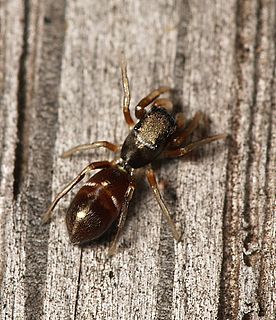
Synageles is a genus of jumping spiders that was first described by Eugène Louis Simon in 1876.
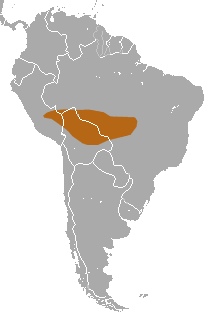
Bishop's slender opossum is a small, arboreal marsupial opossum native to Brazil, Peru, and Bolivia. It somewhat resembles a placental rat or shrew.
Sherman Chauncey Bishop (1887–1951) was a herpetologist and arachnologist from New York. He studied at Cornell University and, with Cyrus R. Crosby, gave the spruce-fir moss spider its scientific name. His Handbook of Salamanders (1943) was the first serious and comprehensive treatment of North American salamanders since Cope (1889).
The reticulated flatwoods salamander is a species of mole salamander, an amphibian in the family Ambystomatidae. The species is native to a small portion of the southeastern coastal plain of the United States in the western panhandle of Florida and extreme southwestern Georgia. The species once occurred in portions of southern Alabama but is now considered extirpated there. Its ecology and life history are nearly identical to its sister species, the frosted flatwoods salamander. A. bishopi inhabits seasonally wet pine flatwoods and pine savannas west of the Apalachicola River-Flint River system. The fire ecology of longleaf pine savannas is well-known, but there is less information on natural fire frequencies of wetland habitats in this region. Like the frosted flatwoods salamander, the reticulated flatwoods salamander breeds in ephemeral wetlands with extensive emergent vegetation, probably maintained by summer fires. Wetlands overgrown with woody shrubs are less likely to support breeding populations.

Brommella is a genus of cribellate araneomorph spiders in the family Dictynidae, and was first described by Albert Tullgren in 1948.
Floricomus is a genus of North American dwarf spiders that was first described by C. R. Crosby & S. C. Bishop in 1925.

Metylophorus is a genus of common barklice in the family Psocidae. There are at least 50 described species in Metylophorus.
Clubiona bishopi is a species of sac spider in the family Clubionidae. It is found in the United States and Canada.
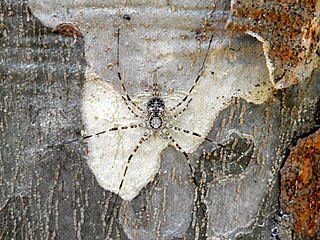
Neotama mexicana, also known as the long-spinneret spider or Mexican two-tailed spider, is a species of tree trunk spider in the family Hersiliidae. It is found in a range from the United States to Peru and Guyana.
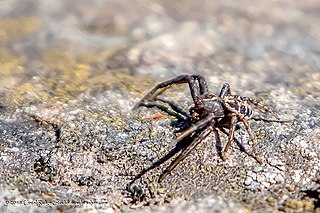
Xysticus emertoni, or Emerton's crab spider, is a species of crab spider in the family Thomisidae. It is found in the United States, Canada, Slovakia, Russia, and a range from Central Asia to China.

Pirata piraticus is a species of wolf spider in the family Lycosidae. It is found in North America, Europe, Turkey, Caucasus, a range from Russia, Central Asia, China, and Japan.

Synageles noxiosus is a species of jumping spider. It is found in Canada, the United States, Mexico, and the Bahamas.
Habronattus tranquillus is a species of jumping spider in the family Salticidae. It is found in the United States and Mexico.

Phidippus apacheanus is a species of jumping spider in the family Salticidae. It is found in the United States, Mexico, and Cuba.
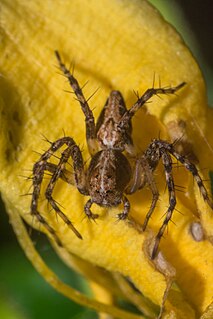
Oxyopes scalaris, the western lynx spider, is a species of lynx spider in the family Oxyopidae. It is found in North America.
Ekaterina Mikhailovna Andreeva also known as Katarzyna Andrejewa-Prószyńska was an Uzbek arachnologist. She collected spiders in Central Asia and later published Spiders of Tajikistan. At least eight spider and harvestman taxa were named in her honor.














